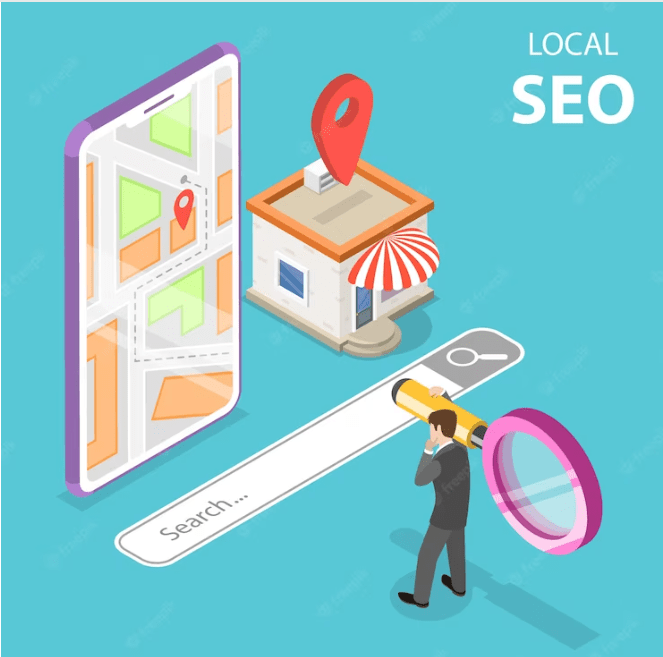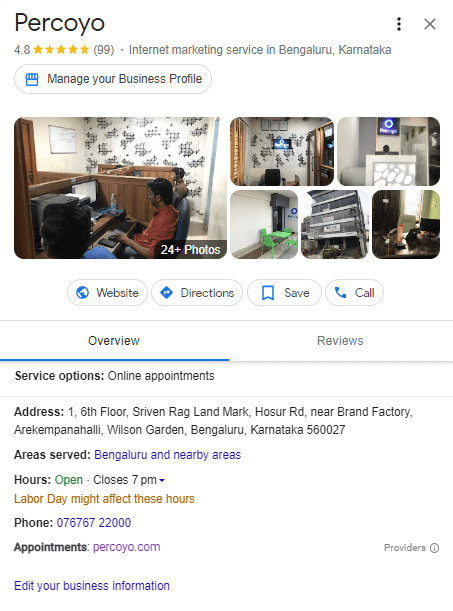It has been seen that around 78% of the users who search for local businesses end up being a purchaser or buyers. This is the reason that most local businesses are switching to local SEO. When you opt for local SEO your only competition will be local businesses online.
This will help you rank at the top of local results if the correct strategies are followed. In this article, we will discuss some of the local strategies that can be followed for small businesses. Let’s look into some of the topics:
- What is Local SEO?
- 12 Local SEO Strategies For Small Businesses
- Optimize Google Business Profile (GBP)
- Social Media Presence
- Name, Address, and Phone Number should be consistent (NAP)
- Optimize for Citations and Directories
- Do a local SEO Audit
- Internal Linking
- Optimize On-Page SEO
- Add Location Pages to your Website
- Create Local Content
- Make sure your website is mobile-friendly
- Inbound Links with Relevancy and Authority
- Engage with the local community
- Local SEO Tools
- Conclusion to Local SEO Strategies For Small Businesses
What is Local SEO?
Local SEO is the process of optimizing local businesses for online visibility. Moreover, by opting for Local SEO services you can improve your organic traffic and brand awareness. Search engines focus on local content, social media presence, inbound links, and citations.

Therefore, by implementing local SEO you can offer your products or services to the users searching online.
12 Local SEO Strategies For Small Businesses

1. Optimize Google Business Profile (GBP)
Google Business Profile is the best tool that can be used to scale up your business. In order to optimize your GBP you will need to:
- Create and verify the Google Business Profile.
- Add Name, Address, and Phone Number.
- Add the categories, products, or services you are offering.
- Add updates to reach out to the customers and engage them.
- You can always ask your customers to share reviews.
- Respond to all the reviews posted whether it is positive or negative.
Once your business profile is established, google will review and authenticate your profile. Moreover, your business will be rewarded with rankings on Local Listings.
Your local listing will look something like this after it is approved.

2. Social Media Presence
Google considers having a presence on social media very important in terms of building relevance and online visibility. You can share the Google Business posts on social media channels.
Some of the common and important social media channels are as follows: Facebook, Instagram, LinkedIn, and Youtube.
3. Name, Address, and Phone Number should be consistent (NAP)
The name address and phone number should be exact and accurate. This should be easily crawlable so that the profile can be displayed when the user searches for local results.
4. Optimize for Citations and Directories
While adding citations you will have to make sure that the NAP should be exactly the same as GBP. However, if there is some sort of grammatical error or change in phone number then there can be a problem.
If the search engine does not see the similarity in the profiles created across directories and citation sites, then your business will not likely show up in search results.
5. Do a local SEO Audit
Instead of performing trial and error tactics to see what’s working, it is better to do a local SEO audit. The audit can be done as specified below:
- GBP Audit – Is the information shown on the profile the same as you desire? If not you should update it.
- Google Search Console (GSC) Audit – Make sure your site is crawlable. If not, Check robots.txt if your website is disallowed and do the necessary changes.
- On-Page Audit – Do an On-Page audit to make sure that every factor is optimized. Like the title tag, URL, Meta Description, Image Alt Text, Internal Links, and External Links.
- Citations – You will have to make sure that all the business listings cited have the exact same NAP.
- Competitor Analysis – By doing this, you can make sure that you follow and understand what they are doing right in order to maintain rankings and show up on local search results.
- Website Audit – You can do a complete website audit and technical audit to see how your website is performing.
6. Internal Linking
Internal linking is an essential part of SEO just like external linking. Internal linking will help you with website navigation, and site hierarchy and also pass on page authority over the pages.
7. Optimize On-Page SEO
Every time you create new content for your website you will have to make sure that you tick boxes for all the metrics for On-Page SEO on your checklist. You have to optimize title tags, meta descriptions, image alt texts, heading structures, internal links, and external links.
You can optimize for local businesses by writing content that is geo-targeted or location specific.
8. Add Location Pages to your Website
You can create pages wherein you can target location-specific users. You can include your Name, Address, and Phone Number along with store pictures and testimonials. Each page created should have unique store descriptions, promotions, and reviews for that particular store.
You can create unique about us pages and embed maps to these pages. Adding Google Maps to your website page can reward your business.
9. Create Local Content
You should always focus on writing for users rather than search engines. However, writing about general topics on your niche can generate traffic, but it is always better to include local content to generate leads and increase ROI.
Creating content by keeping local intent in mind will help you gain business traction as well as inbound links from local businesses as well.
10. Make sure your website is mobile-friendly
Around 61% of the local searches are performed on mobile and most of them end up being a purchaser or buyer. Most of the searches are done to see reviews, locations, and directions to these locations. Moreover, “near me” intent searches have increased to 250% from 2017.
Making your website mobile-friendly will improve the user experience and them staying and converting into customers.
11. Inbound Links with Relevancy and Authority
Inbound links can benefit local SEO. The inbound links tell Google that your website is relevant and will also your domain authority. You can get inbound links by doing guest posts, PR, and by writing extraordinary content.
12. Engage with the local community
The more you engage with the local community, the more you will improve the brand presence. Sponsoring an event, or appearing in the local media can get you inbound links.
Local SEO Tools
Local SEO can be implemented with the help of SEO tools to improve online visibility, organic traffic, and sales. In order to track the performance of your listings you will need some SEO tools. Some of these tools are paid. They are as follows:
- Google Business Profile
- Yext
- Whitespark
- Synup
- Moz Local
- SEMRush
- Brightlocal
- Growthbar
- Google Search Console
- Google Analytics
- BiQ
- Review Trackers
- GEO Ranker
Conclusion to Local SEO Strategies For Small Businesses
In conclusion, Local SEO is an important part of establishing an online presence for any business. Local SEO can be used to get brand presence as well as get leads to your business. It also helps the users to reach you if you have a physical store.
You can start your SEO journey with us, we specialize in optimizing GBP for local businesses. Call us at +91 7676722000 or fill out the form below, so that our experts can get back to you.
